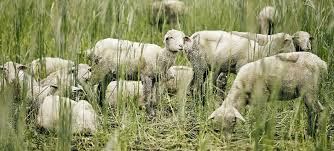Raising sheep on pasture is a sustainable and cost-effective way to manage a flock, but providing adequate shelter is essential for their health, comfort, and productivity. A well-designed sheep shelter protects animals from harsh weather, predators, and stress while allowing them to thrive in a natural grazing environment.
Building your own sheep shelter can be a rewarding DIY project that saves money and allows customization based on your flock’s needs. In this guide, we’ll cover:
- Why Sheep Need Shelter
- Key Considerations Before Building
- Types of DIY Sheep Shelters
- Step-by-Step Construction Plans
- Maintenance and Upkeep
By the end, you’ll have the knowledge to construct a durable, functional, and cost-effective shelter for your pasture-raised sheep.
Table of Contents
1. Why Sheep Need Shelter
Sheep are hardy animals, but they still require protection from:
- Extreme Weather – Heavy rain, snow, wind, and excessive heat can stress sheep, leading to illness or reduced productivity.
- Predators – Coyotes, dogs, and foxes pose threats, especially to lambs.
- Parasites & Disease – Muddy, wet conditions increase the risk of hoof rot and parasites.
- Lambing Needs – Pregnant ewes require a clean, dry space for safe lambing.
A good shelter doesn’t need to be elaborate—just sturdy, well-ventilated, and appropriately sized.
2. Key Considerations Before Building
A. Shelter Size Requirements
- General Rule: Allow 15–20 sq ft per adult sheep (more for pregnant ewes).
- Lambing Area: Additional space (8–10 sq ft per ewe) if used for birthing.
- Height: At least 6–8 ft tall for ventilation and human access.
B. Location & Orientation
- Place the shelter on high ground to avoid flooding.
- Face the opening away from prevailing winds (e.g., south-facing in the Northern Hemisphere for winter sun).
- Ensure easy access to pasture, water, and feed.
C. Materials & Cost
- Wood (most common, durable, easy to work with)
- Metal roofing (long-lasting, sheds snow/rain well)
- PVC or Polyethylene (for lightweight, portable options)
- Salvaged materials (pallets, old barn wood, etc.)
D. Ventilation & Drainage
- Avoid airtight designs—ammonia buildup from urine is harmful.
- Overhangs or raised floors help keep bedding dry.
- Open-sided designs work well in mild climates.
3. Types of DIY Sheep Shelters
A. Three-Sided Pole Barn
- Best for: Permanent, all-weather protection.
- Pros: Sturdy, excellent airflow, predator-resistant.
- Cons: Requires more materials and labor.
B. Hoop House (PVC or Cattle Panel)
- Best for: Portable, low-cost shelters.
- Pros: Easy to move, good for rotational grazing.
- Cons: Less durable in high winds.
C. Pallet Shelter
- Best for: Budget-friendly, quick assembly.
- Pros: Uses recycled materials, modular.
- Cons: Requires reinforcement for longevity.
D. Lean-To Shelter
- Best for: Small flocks, attached to existing barns.
- Pros: Simple, space-efficient.
- Cons: Limited space, less wind protection.
4. Step-by-Step Construction Plans (Three-Sided Pole Barn)
Materials Needed:
- (4) 4×4 or 6×6 treated posts (8 ft tall)
- (2) 2×6 treated beams (10–12 ft long)
- (6–8) 2×4 rafters (8 ft long)
- Corrugated metal roofing (10–12 ft sheets)
- Exterior screws/nails
- Concrete (for post stability, optional)
- Hardware cloth (optional for predator-proofing)
Step 1: Site Preparation
- Clear and level the ground.
- Mark post locations (e.g., 10×12 ft rectangle).
Step 2: Set Posts
- Dig holes 2–3 ft deep for corner posts.
- Secure posts with concrete or tamped earth.
Step 3: Install Beams & Roof Frame
- Attach horizontal beams across the top of the posts.
- Space rafters 2 ft apart, securing to beams.
Step 4: Add Roofing
- Overlap metal sheets, screw into rafters.
- Extend roof 1–2 ft beyond shelter for rain runoff.
Step 5: Optional Walls & Flooring
- Leave one side fully open (three-sided design).
- Add hardware cloth if predators are a concern.
- Use gravel or wood chips for drainage.
Step 6: Bedding & Finishing Touches
- Spread straw or wood shavings for insulation.
- Provide windbreaks if needed (tarps, plywood).
5. Maintenance & Upkeep
- Clean bedding regularly to prevent disease.
- Inspect for rot or damage (especially wooden structures).
- Re-position portable shelters to avoid mud buildup.
- Check for predator entry points (digging, gaps).
Here are 10 frequently asked questions about sheep:
1. How long do sheep live?
- Sheep typically live 10–12 years, though some can live longer with proper care.
2. What do sheep eat?
- Sheep are herbivores and primarily graze on grass, hay, and clover. They may also eat grains and supplemental feed.
3. How many stomachs do sheep have?
- Sheep are ruminants with four stomach compartments: the rumen, reticulum, omasum, and abomasum.
4. Why do farmers raise sheep?
- Sheep are raised for wool, meat (lamb/mutton), milk, and leather. Some are also kept for land management (grazing).
5. How often do sheep need shearing?
- Most sheep breeds need shearing once a year to prevent overheating and maintain wool quality.
6. Do sheep have good memory?
- Yes, sheep have strong memories—they can recognize faces (of other sheep and humans) and remember locations for years.
7. Can sheep survive in cold weather?
- Yes, sheep grow thick wool that insulates them, but they still need shelter from wind and rain in extreme conditions.
8. How many lambs do sheep have per pregnancy?
- Most sheep have 1–2 lambs per pregnancy, though some breeds (like the Finnsheep) can have triplets or more.
9. Are sheep intelligent?
- Sheep are smarter than many think—they can solve problems, learn routines, and show emotions like stress or happiness.
10. Do sheep make good pets?
- Some breeds (like Dorset or Suffolk) can be friendly and manageable as pets, but they require space, proper fencing, and care.

